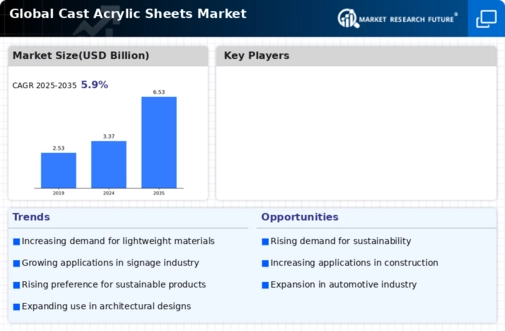Market Growth Projections
The Global Cast Acrylic Sheets Market Industry is poised for substantial growth, with projections indicating a market value of 3.37 USD Billion in 2024 and an impressive increase to 6.53 USD Billion by 2035. This growth trajectory reflects a compound annual growth rate of 6.18% from 2025 to 2035, driven by factors such as rising demand for lightweight materials, technological advancements, and increasing applications across diverse industries. The market's expansion is indicative of the ongoing evolution in material science and the growing preference for acrylic sheets in various applications, suggesting a promising future for the industry.
Growing Awareness of Sustainability
Sustainability concerns are becoming increasingly prominent in the Global Cast Acrylic Sheets Market Industry, as consumers and businesses alike prioritize eco-friendly materials. Cast acrylic sheets are often regarded as a more sustainable option compared to glass, due to their lower energy consumption during production and recyclability. This shift towards sustainable practices is evident in various industries, including retail and signage, where companies seek to reduce their environmental footprint. As awareness of sustainability continues to grow, the market for cast acrylic sheets is likely to expand, driven by the demand for environmentally responsible materials that align with corporate social responsibility initiatives.
Increasing Demand for Lightweight Materials
The Global Cast Acrylic Sheets Market Industry experiences a notable surge in demand for lightweight materials across various sectors, including automotive, construction, and signage. As industries seek to enhance fuel efficiency and reduce overall weight, acrylic sheets emerge as a preferred alternative to traditional glass and other heavier materials. This trend is particularly evident in the automotive sector, where manufacturers are increasingly adopting acrylic sheets for windows and interior components. The market is projected to reach 3.37 USD Billion in 2024, reflecting the growing inclination towards lightweight solutions that contribute to sustainability and performance improvements.
Rising Applications in the Construction Sector
The construction sector plays a pivotal role in driving the Global Cast Acrylic Sheets Market Industry, as these materials are increasingly utilized in architectural designs, facades, and interior applications. The aesthetic appeal and durability of acrylic sheets make them an attractive choice for modern buildings. Furthermore, their ability to provide excellent light transmission and insulation properties enhances energy efficiency in structures. As urbanization continues to accelerate globally, the demand for innovative building materials rises, further propelling the market. The anticipated compound annual growth rate of 6.18% from 2025 to 2035 underscores the construction sector's influence on the acrylic sheets market.
Diverse Applications Across Multiple Industries
The versatility of cast acrylic sheets contributes significantly to the Global Cast Acrylic Sheets Market Industry, as they find applications in a wide array of sectors, including healthcare, automotive, and consumer goods. In healthcare, for example, acrylic sheets are utilized for protective barriers and equipment enclosures, enhancing safety and visibility. The automotive industry employs these materials for lightweight components, while consumer goods leverage their aesthetic qualities for packaging and displays. This broad applicability not only drives market growth but also fosters innovation in product development, catering to the unique needs of various industries.
Technological Advancements in Manufacturing Processes
Technological innovations in the production of cast acrylic sheets significantly bolster the Global Cast Acrylic Sheets Market Industry. Advanced manufacturing techniques, such as extrusion and casting, enhance the quality and versatility of acrylic sheets, enabling their application in diverse fields. For instance, the introduction of automated processes allows for greater precision and efficiency, reducing production costs and waste. These advancements not only improve product quality but also expand the range of available designs and finishes. As a result, the market is expected to grow steadily, with a projected value of 6.53 USD Billion by 2035, indicating a robust trajectory driven by technological progress.



Leave a Comment